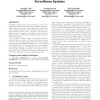Free Online Productivity Tools
i2Speak
i2Symbol
i2OCR
iTex2Img
iWeb2Print
iWeb2Shot
i2Type
iPdf2Split
iPdf2Merge
i2Bopomofo
i2Arabic
i2Style
i2Image
i2PDF
iLatex2Rtf
Sci2ools
KDD
2004
ACM
2004
ACM
Belief state approaches to signaling alarms in surveillance systems
Surveillance systems have long been used to monitor industrial processes and are becoming increasingly popular in public health and anti-terrorism applications. Most early detection systems produce a time series of p-values or some other statistic as their output. Typically, the decision to signal an alarm is based on a threshold or other simple algorithm such as CUSUM that accumulates detection information temporally. We formulate a POMDP model of underlying events and observations from a detector. We solve the model and show how it is used for single-output detectors. When dealing with spatio-temporal data, scan statistics are a popular method of building detectors. We describe the use of scan statistics in surveillance and how our POMDP model can be used to perform alarm signaling with them. We compare the results obtained by our method with simple thresholding and CUSUM on synthetic and semi-synthetic health data. Categories and Subject Descriptors I.2.6 [Artificial Intelligence]:...
| Added | 30 Nov 2009 |
| Updated | 30 Nov 2009 |
| Type | Conference |
| Year | 2004 |
| Where | KDD |
| Authors | Kaustav Das, Andrew W. Moore, Jeff G. Schneider |
Comments (0)

